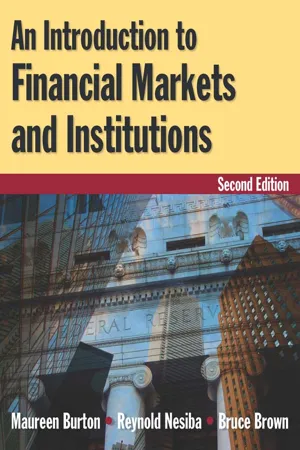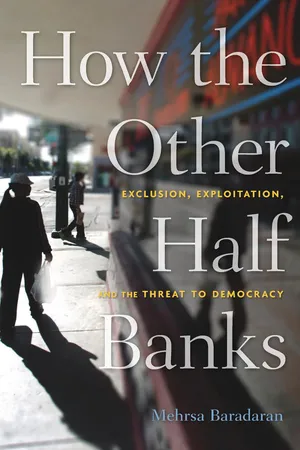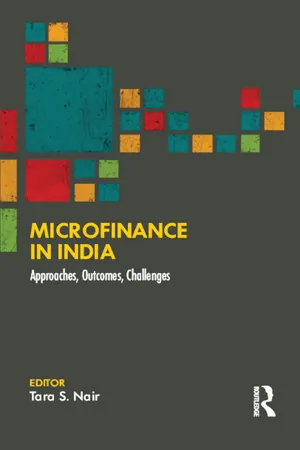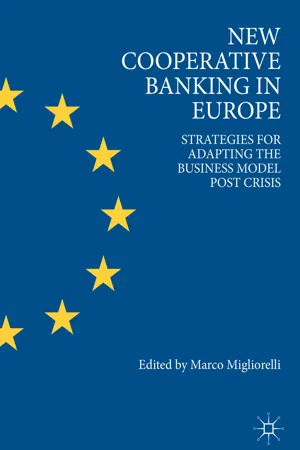Credit Unions
Credit unions are member-owned financial cooperatives that provide a range of banking services, including savings accounts, loans, and other financial products. They are not-for-profit organizations and are governed by a volunteer board of directors elected by the members. Credit unions often focus on serving specific communities or groups, and they are known for their emphasis on customer service and community involvement.
6 Key excerpts on "Credit Unions"
- eBook - ePub
Retail and Digital Banking
Principles and Practice
- John Henderson(Author)
- 2018(Publication Date)
- Kogan Page(Publisher)
...Unlike traditional banks, Credit Unions have no shareholders and therefore do not need to generate profit – their sole aim is to serve the needs of their members. Credit Unions have played and continue to play a vital role in the local economies of countries around the world, in particular through the provision of financial services to some of the most vulnerable communities in society. Why people become members of Credit Unions: to help themselves by saving on a regular basis; it is social responsibility to support and help other members and the community; to generate an alternative source of credit for the benefit of members at a fair and reasonable rate of interest; to maximize community financial resources and to support the need of individuals. Credit union A group of people with a common bond, who save together and lend to each other at a reasonable rate of interest. The evolution of Credit Unions Franz Hermann Schulze-Delitzsch established the first Credit Unions in the 1850s in Germany to give those (in the first case mill workers) lacking access to financial services the opportunity to borrow from the savings pooled by themselves and their fellow members (World Council of Credit Unions, 2018). The first rural credit union was established a decade later by Friedrich Raiffeisen in southern Germany in 1849. The primary objective was to provide groups of individuals who share a common bond access to financial services. This remains the underlying principle today. In the early 20th century, the credit union concept expanded to North America...
- Maureen Burton, Reynold F. Nesiba, Bruce Brown(Authors)
- 2015(Publication Date)
- Routledge(Publisher)
...Unlike savings associations, which specialize in the provision of long-term housing credit, Credit Unions specialize in small, short-term consumer loans. Also unlike a savings association, the general public cannot “join”—deposit into or borrow from—a particular credit union. By law, members must share a common bond such as an employer, a church, a labor union, or a geographic region. As of 2008, the Credit Union National Association (CUNA) reported that over 85 million Americans, many of them federal government, state government, and public utilities employees, were members of the 8,362 Credit Unions in operation. Among the 20 largest federally insured Credit Unions in the United States are the Navy, the North Carolina State Employees, the Pentagon, the Orange County Teachers, and the Boeing employees’ Credit Unions. The history of Credit Unions is similar to that of savings institutions—they arose out of frustration with the lack of attention commercial banks gave to the saving and credit needs of ordinary working people. Although savings institutions were created to help address these needs with respect to mortgage credit, the need for small loans to buy automobiles and furniture, or for home improvements and other personal expenses, remained unmet. The credit union filled this niche. The first Credit Unions began in Germany in the 1840s. They spread to Quebec in 1900 and finally to the United States in 1909 with the establishment of St. Mary’s Cooperative Credit Association in Manchester, New Hampshire. In 1914, the Massachusetts Credit Union (MCU) was organized both to serve as a regular credit union and to assist with the creation of new Credit Unions. Over time it evolved into a kind of central credit union and trade association for the industry. In 1921, the MCU became the Credit Union National Extension Board (CUNEB), whose primary purpose was to expand the credit union movement across the country...
- eBook - ePub
How the Other Half Banks
Exclusion, Exploitation, and the Threat to Democracy
- Mehrsa Baradaran(Author)
- 2015(Publication Date)
- Harvard University Press(Publisher)
...The act also did nothing to assuage the banking industry’s fears that Credit Unions were acting essentially like banks without having to pay taxes or comport with Community Reinvestment Act requirements. Today, Credit Unions are much like mainstream banks. The American Bankers Association argues that Credit Unions are not fulfilling their mission to serve the underserved. 55 Of course, the banks are biased, but the assertion is not unfair. A 2006 Government Accountability Office study concluded that compared to banks, Credit Unions are more likely to serve middle- and upper-income people than lower-income people. 56 Notably, some even claim that Credit Unions “come in and cherry-pick the most profitable [banking] business and then give nothing back to the community,” a practice far from the original mission of the cooperatives that Filene and then Roosevelt embraced. 57 The lore of the credit union has outlived its reality. For many, the credit union still stands as the answer to everything that is wrong with banking. To be sure, Credit Unions do differ from banks. Though they are now quite large, none are as large as the Too-Big-to-Fail banks. In addition, their structure limits their appetite for risk. Credit union boards still consist of community members. Even though their mission is to make a profit, they are not willing to make profits at all costs. However, most Credit Unions do not see banking for the poor as a part of their mission. The credit union was a twentieth-century response to a twentieth-century problem. Insisting that this once-revolutionary institution continue to solve twenty-first-century problems of access misunderstands not only the modern credit union industry but also the modern problems of credit. Specifically, many place the onus of helping the poor on a small subset of Credit Unions called Community Development Credit Unions (CDCUs). As the credit union industry abandoned its initial mission, some held their ground...
- eBook - ePub
- Robert A Cropf(Author)
- 2015(Publication Date)
- Routledge(Publisher)
...The capital of Credit Unions comes from the purchase of shares by members, who in turn receive dividends based on their investment. Unlike other banks, Credit Unions are not driven by profit motives. Instead, they are committed to providing a higher quality of customer service and issuing loans at lower interest rates to their members than do for-profit banks. Within the Centreville metropolitan area, the Community Credit Union (CCU) is a rapidly expanding financial institution, with a mission to provide a high level of services to its members. In Community’s case, each member pays a nominal $5 fee to join. Everyone who banks with Community is treated as a stakeholder and beneficiary of its future success or failure. According to its mission, success is based on two criteria: customer satisfaction and the credit union’s ability to provide appropriate products and advice for members to grow their wealth and to achieve a certain level of financial responsibility. These commitments are summed up by a phrase the institution’s management uses: “To serve the community without profit or charity.” CCU traces its origin to members of the Centreville Suburban Teachers Association (CSTA). As time went on, membership and total assets of the cooperative grew rapidly, spurring the credit union to change its name to Educational Employees Credit Union (EECU). The new name reflected expanding membership eligibility to those outside the teaching profession and away from the immediate metropolitan region. EECU continued to merge with smaller educational Credit Unions until it combined with Universal Credit Union (whose membership included manufacturing employees). Finally, the institution’s name was changed to Community Credit Union to more accurately describe the diverse membership of the organization. In order to maintain a competitive edge with rival Credit Unions and for-profit banks, CCU strives to offer a wide variety of special services to its membership...
- eBook - ePub
Microfinance in India
Approaches, Outcomes, Challenges
- Tara S. Nair, Tara S. Nair(Authors)
- 2018(Publication Date)
- Routledge India(Publisher)
...8 Microfinance and Cooperatives An Overview Navin Anand C ooperatives are critical institutions in the process of achieving social and financial inclusion. Whereas the social inclusion issue is addressed by sub-sectoral and service cooperatives, savings and credit cooperatives function as inclusive financial intermediaries. Within the microfinance movement, globally, credit cooperatives and unions have a unique place as their membership is constituted largely by small farmers and petty entrepreneurs. In India the provision of financial services through cooperatives began in an organised manner after the enactment of the Cooperative Credit Societies Act 1904. Constitutionally, cooperatives is a state subject. Registered under respective state legislations their activities are restricted to single states. Only those registered under the Multi State Cooperative Societies Act (MSCSA) are entitled to operate in more than one state. There are two distinct parts to the rural credit cooperative system in India dealing with for lending on long and short/medium terms. The long term cooperative structure 1 provides loans mainly for agricultural investment. The short term cooperative credit structure (STCCS) is three-tiered with primary agricultural credit societies (PACS) at the village level, district central cooperative banks (DCCBs) at the district level and state cooperative banks (SCBs) at the apex (state) level. In the urban areas, urban cooperative banks and societies are the primary level structures. Table 8.1 gives a detailed structure of the cooperative credit system. It is important to mention here that the data covered by RBI reflects only the financial cooperatives that are reporting to RBI and therefore it mainly covers traditional cooperatives. The new age or self-reliant cooperatives that have emerged in the recent past are not reported in the data of RBI...
- eBook - ePub
New Cooperative Banking in Europe
Strategies for Adapting the Business Model Post Crisis
- Marco Migliorelli, Marco Migliorelli(Authors)
- 2018(Publication Date)
- Palgrave Macmillan(Publisher)
...Nevertheless, even though limited, evidence shows that cooperatives appear to grant a better treatment to borrowers as regards sharing the rent generated by credit relationships. 29 1.5 Characteristics of the Support of Cooperative Banks to the Economy Cooperative banking has been given considerably more attention by the economic researchers since the outbreak of the Great Crisis. A growing body of empirical work seeks to analyse how the governance and ownership characteristics of cooperative banks affect not only their own behaviour but also the entire banking system. These specificities are generally examined in a comparative perspective: the merits of cooperative banks are relatively assessed against the practices of other banks, chiefly commercial, capitalistic banks, which are deemed to represent the standard banking institutions. The archetypical model of credit cooperatives, as outlined above, has undergone significant changes over the last century to form large banking groups (Ayadi et al. 2010). Even though cooperative banks have pursued hybridisation strategies by evolving in some cased into full-service universal banks or by entering into activities that were not inherently entrenched, such as corporate and investment banking (Ory and Lemzeri 2012), they still appear to be anchored to their business basics and firmly adhere to traditional intermediation. 30 In the context of France, Gianfaldoni and Richez-Battesti (2005) show that cooperative banks are by far the main external funders of SMEs and households. Labye et al. (2002) and Ayadi et al. (2010) generalise these findings to Europe by showing that cooperative banks are major retail banking players in most EU countries. More formal proof of cooperative banks ’ support to the real economy is brought by Becchetti et al. (2016)...





